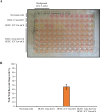The Pioneer platform: A novel approach for selection of selective anti-cancer cytotoxic activity in bacteria through co-culturing with engineered human cells
- PMID: 37279202
- PMCID: PMC10243623
- DOI: 10.1371/journal.pone.0286741
The Pioneer platform: A novel approach for selection of selective anti-cancer cytotoxic activity in bacteria through co-culturing with engineered human cells
Abstract
Most of the small-molecule drugs approved for the treatment of cancer over the past 40 years are based on natural compounds. Bacteria provide an extensive reservoir for the development of further anti-cancer therapeutics to meet the challenges posed by the diversity of these malignant diseases. While identifying cytotoxic compounds is often easy, achieving selective targeting of cancer cells is challenging. Here we describe a novel experimental approach (the Pioneer platform) for the identification and development of 'pioneering' bacterial variants that either show or are conduced to exhibit selective contact-independent anti-cancer cytotoxic activities. We engineered human cancer cells to secrete Colicin M that repress the growth of the bacterium Escherichia coli, while immortalised non-transformed cells were engineered to express Chloramphenicol Acetyltransferase capable of relieving the bacteriostatic effect of Chloramphenicol. Through co-culturing of E. coli with these two engineered human cell lines, we show bacterial outgrowth of DH5α E. coli is constrained by the combination of negative and positive selection pressures. This result supports the potential for this approach to screen or adaptively evolve 'pioneering' bacterial variants that can selectively eliminate the cancer cell population. Overall, the Pioneer platform demonstrates potential utility for drug discovery through multi-partner experimental evolution.
Copyright: © 2023 Garland et al. This is an open access article distributed under the terms of the Creative Commons Attribution License, which permits unrestricted use, distribution, and reproduction in any medium, provided the original author and source are credited.
Conflict of interest statement
The authors have declared that no competing interests exist.
Figures





References
Publication types
MeSH terms
Substances
Grants and funding
LinkOut - more resources
Full Text Sources
Medical
Miscellaneous

